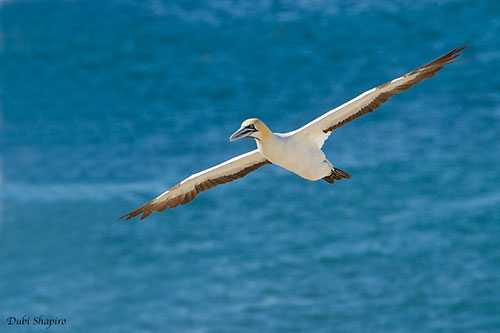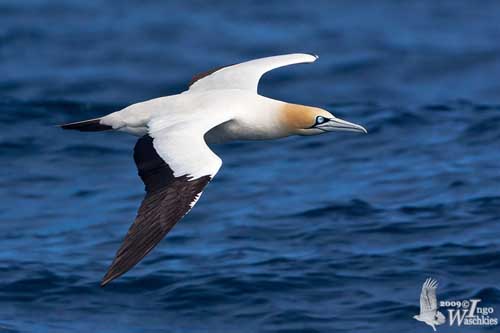
Fr: Fou du Cap
All : Kaptölpel
Esp : Alcatraz de El Cabo
Ital : Sula del Capo
Nd: Kaapse Jan-van-gent
Sd: Kapsula
Afrikaans: Witmalgas
Photographers:
Ken Havard
My Bird Gallery & Flickr gallery 1 & Flickr gallery 2
Dubi Shapiro
Dubi Shapiro Photo Galleries
Ingo Waschkies
Bird Photography
Text by Nicole Bouglouan
Sources:
HANDBOOK OF THE BIRDS OF THE WORLD vol 1 by Josep del Hoyo-Andrew Elliot-Jordi Sargatal - Lynx Edicions - ISBN: 8487334105
BIRDS OF AFRICA SOUTH OF THE SAHARA by Ian Sinclair and Peter Ryan - Princeton University Press Princeton and Oxford - ISBN: 0691118159
ROBERTS BIRDS OF SOUTH AFRICA by G. R. Mc Lachlan and R. Liversidge – The Trustees of the John Voelcker Bird Book Fuund – ISBN: 0620031182
BirdLife International (BirdLife International)
Wikipedia, the free encyclopaedia
Cape Gannet
Morus capensis
Suliformes Order – Sulidae Family
BIOMETRICS:
Length: 85-90 cm
Weight: 2600 g
DESCRIPTION:
The Cape Gannet is a large marine bird which breeds on islands off the South African coasts. It belongs to the genus Morus with the Northern Gannet and the Australasian Gannet.
This bird is very similar to other Morus species. It has white plumage overall, except on black secondary and primary flight feathers and tail. As in other gannets, head and hindneck are golden yellow, but the black gular stripe is longer than in other species, with a size of about 15 cm down the foreneck.
On the face, the bare skin around the eyes and on lores is black, extending to the lower base of bill and joining down the gular stripe.
The stout bill is pale blue. The eyes are white, surrounded by bare blue eyering. Legs and webbed feet are black, but toes are pale greenish-white.
These colours may become slightly duller outside the breeding season.
Both sexes are similar.

The juvenile is brown with white spots.
The immature has white body with dark brown upperparts. It gains gradually the white adult plumage. Juvenile and immature differ from other Morus young birds by the long, black gular stripe. They can breed at 3-4 years of age.
VOICE: SOUNDS BY XENO-CANTO
The Cape Gannet is noisy at colonies and when feeding at sea in flocks. They give loud, raucous and repeated “warra-warra-warra…”
HABITAT:
The Cape Gannet, as other Sulidae species, is a strictly marine bird. It wanders continuously over the continental shelf.
They can be seen on flat offshore islands where they nest in huge and noisy colonies.
RANGE:
The Cape Gannet breeds along the South African and Namibian coasts.
They winter along the coasts from Gulf of Guinea to Mozambique, exceptionally to Kenya.
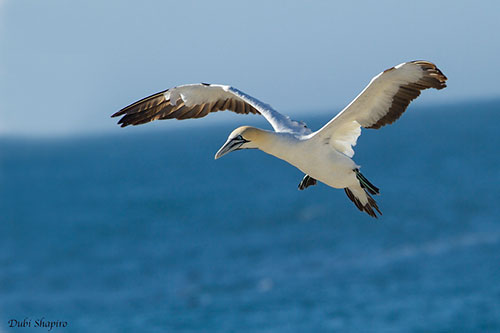
BEHAVIOUR:
The Cape Gannet feeds on fish and cephalopods such as pilchards (Sardinops ocellata), anchovies (Engraulis capensis) and Atlantic saury (Scomberesox saurus) making about 90% of its diet. But some other species are also taken.
As other gannets, it performs plunge-diving from about 20-30 metres height into the sea. Large flocks often accompany the sardine-run up the east coasts every year in June and July. They also follow the trawlers where large fish aggregations are available.
The Cape Gannet is gregarious and has intense social life. They nest in huge colonies very close to each other.
Numerous ritualized displays are used in such dense colonies. We can see frequent “headshake” for communication, “bowing” and “sky-pointing” in threat displays, and greeting ceremony. Other ritualized postures indicate the intention of movement of a bird around its territory or away from its mate, involving “sky-pointing” too.
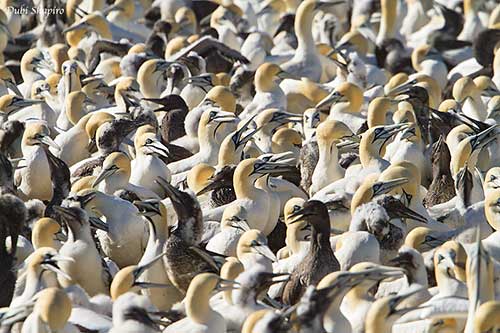
The Cape Gannets pairs for life. Both mates return every year to their nest-site after long time spent wandering about at sea. The displays may last several weeks before the beginning of the laying.
The adults usually stay in adjacent waters, within 500 km of the breeding grounds, after the nesting period. But the young birds migrate N to Gulf of Guinea and a few off Mozambique.
FLIGHT:
The Cape Gannet frequently glides up in an arch and down again. It dives from height into the sea when fishing.
The wings appear narrow and pointed, and the head is stretched forwards. The wing motion is unbending.
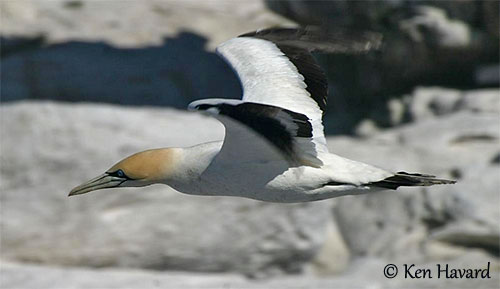
REPRODUCTION:
The breeding season occurs between September and April.
The Cape Gannet nests in huge colonies on flat grounds or slightly sloping open ground on offshore islands. The nests are very close to each other, involving aggressive encounters between neighbours, sometimes quite violent.
The nest is a mound of guano and debris of vegetation cemented together with excreta. There is a central depression, forming a small hollow-toped cone.
The female lays one egg, rarely two, on the bare ground. Incubation by both sexes is made by the large webbed feet and lasts about 44 days. The chick has blackish skin covered with white down. It fledges between 12 and 16 weeks after hatching. It takes the food directly from the parent’s mouth.
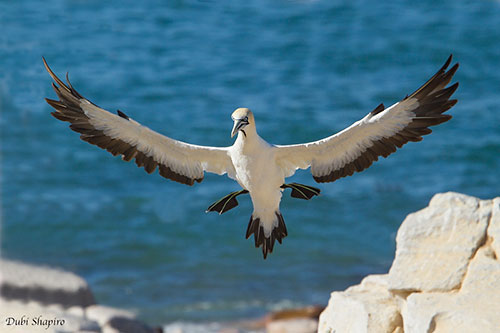
DIET:
The Cape Gannet feeds on several fish species and cephalopods caught by plunge-diving from some height.
PROTECTION / THREATS / STATUS:
The Cape Gannet has restricted breeding range on six offshore islands. Overfishing by humans also reduces the numbers of preys. Oil pollution is an important threat too, for these strictly marine birds.
For these reasons, the species is listed as Vulnerable by Birdlife International.
